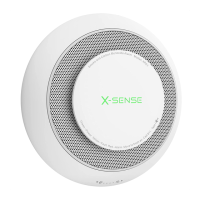15 16
2. NEVER USE A VEHICLE EXHAUST TO TEST THIS UNIT. EXHAUST FUMES MAY CAUSE PERMANENT
DAMAGE AND VOID YOUR WARRANTY.
3. DO NOT STAND CLOSE TO THE ALARM WHEN THE ALARM IS SOUNDING. EXPOSURE AT CLOSE
RANGE MAY BE HARMFUL TO YOUR HEARING. WHEN TESTING, STEP AWAY WHEN THE ALARM
BEGINS TO SOUND.
Maintenance
To keep your smoke/CO alarm in good working order, follow these simple steps:
1. Verify the unit’s alarm sound and indicators are working properly by testing the unit once a week.
2. Remove the unit from the ceiling/wall and clean the alarm cover and vents with a soft brush
attachment once a month to remove dust and dirt.
3. Never use detergents or other solvents to clean the unit.
4. Avoid spraying air fresheners, hair spray or other aerosols near the alarm.
5. Do not paint the unit. Paint will seal the vents and interfere with the sensor’s ability to detect smoke
or CO. Never attempt to disassemble the unit or clean inside. Doing so will void your warranty.
6. When removed, place the smoke/CO alarm back in its proper location as soon as possible, to assure
continuous protection from fi re or carbon monoxide poisoning.
7. When household cleaning supplies or similar contaminants are used, the area should be ventilated.
What You Need to Know About CO
CO cannot be seen, smelled or tasted and can be fatal. The build-up of CO in the blood is called the
carboxyhemoglobin (COHb) level and interferes with the body’s ability to supply itself with oxygen.
Depending on the concentration, CO can kill in minutes. The most common sources of CO are
malfunctioning gas appliance used for heating and cooking, vehicles running in an attached garage,
blocked chimneys or fl ues, portable fuel burning heaters, fi replaces, fuel powered tools and operating a
grill in an enclosed space.
Indications of carbon monoxide poisoning include symptoms similar to the fl u, but with no fever. Other
symptoms include dizziness, fatigue, weakness, headache, nausea, vomiting, sleepiness and confusion.
Everyone is susceptible to the danger of CO, but experts agree that unborn babies, small children,
pregnant women, senior citizens and people with heart or respiratory problems are at the highest
risk for serious injury or death. Every year a qualifi ed technician should inspect and clean your heating
system, vents, chimney, and fl ues.
The following symptoms are related to carbon monoxide poisoning and should be discussed with all
members of the household:
Mild exposure: Slight headache, nausea, vomiting, fatigue (often described as “Flu-like” symptoms).
Medium exposure: Severe throbbing headache, drowsiness, fast heart rate.
Extreme exposure: Unconsciousness, cardiorespiratory failure, death.
The above levels of exposure relate to healthy adults. Levels diff er for those at high risk. Exposure to
high levels of carbon monoxide can be fatal or cause permanent damage and disabilities. Many cases
of reported carbon monoxide poisoning indicate that while victims are aware they are not well, they
become so disoriented they are unable to save themselves by either exiting the building, or calling for
assistance. Also, young children and household pets may be the fi rst aff ected. Familiarization with the
eff ects of each level is important.
Following Conditions Can Result in Transient CO Situations:
•
Excessive spillage or reverse venting of fuel-burning appliances caused by outdoor ambient
conditions, such as wind direction and/or velocity, including high gusts of wind, heavy air in the vent
pipes (cold/humid air with extended periods between cycles).
•
Negative pressure resulting from the use of exhaust fans.
•
Simultaneous operation of several fuel-burning appliances competing for limited internal air.
•
Vent pipe connections vibrating loose from clothes dryers, furnaces, or water heaters.
•
Obstructions in, or unconventional, vent pipe designs which can amplify the above situations.
•
Extended operation of unvented fuel-burning devices (range, oven, fi replace, etc.).
•
Temperature inversions which can trap exhaust gases near the ground.
•
A car idling in an open or closed attached garage, or near a home.

